Choosing a fragrance from all the fragrances out there is a big choice! There are sooooo many good ones =) One important factor to consider is fragrance discoloration. Some fragrance oils change the color of soap due to various components within the oil. The most common type of fragrance discoloration is vanilla discoloration, which changes the soap to a deep brown. Fragrance oils can also turn soap various shades of yellow, tan, and orange. Fragrance oil discoloration can dramatically change the colors created in soap, so it’s important to choose your fragrance oil (FO) wisely.
Vanilla discoloration is a natural occurrence. Fragrances containing vanilla notes are created with a component called vanillin, which is the primary component of the extract of vanilla bean. Vanillin is the organic compound that gives vanilla its flavor, and is widely used in fragrances to impart gourmand sweetness. The chemical nature of vanillin leads it to cause a darkening or browning, especially of white products. This effect also occurs with natural vanilla extract. The higher the level of vanillin within the fragrance oil, the more darkening will occur. Even fragrances with a small amount of vanillin content of .4% (such as Almond Fragrance Oil) will still cause slight discoloration.
Fragrance discoloration becomes noticeable in cold process soap within the first 24-48 hours. When soap begins to discolor, you may notice a darker ring of color on the outside of the soap. Vanilla discoloration is accelerated by light and air, known as oxidation. Once the soap is cut and light/air is able to reach the center, the discoloration will rapidly progress throughout the soap. The photo below is an example of the beginnings of vanilla discoloration starting from the outside, and working towards the center. (Bonus technical information: that crack at the very top of the soap that is barely detectible? That’s from heat. Soap that gets too hot expands and can crack down the middle.)
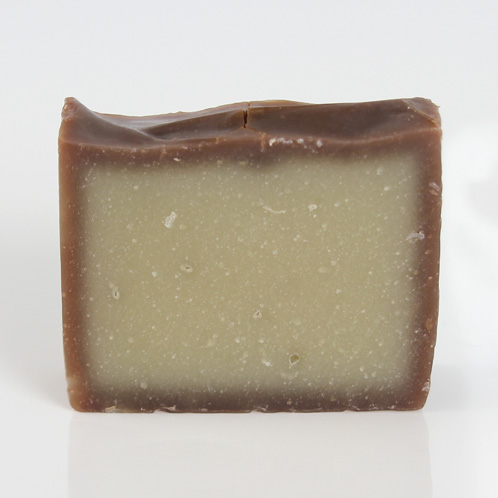 Vanilla discoloration is accelerated by contact with light and air. It is common to notice the discoloration on the outside of the soap first. Eventually, the discoloration will occur throughout the soap.
Vanilla discoloration is accelerated by contact with light and air. It is common to notice the discoloration on the outside of the soap first. Eventually, the discoloration will occur throughout the soap.
There are stabilizers for vanillin, such as the Vanilla Color Stabilizer for melt and pour, however they only delay the inevitable. Using a white colorant such as Titanium Dioxide can lighten discoloration, but eventually the soap will still darken over time. To learn more about vanilla discoloration, along with a list of fragrances containing vanillin, click here.
Because of the deep brown color vanilla can cause, choosing the right fragrance oil is critical to your soap design. To help make the process of selecting fragrance oils easier, the most popular Bramble Berry fragrance oils were tested for fragrance discoloration. The soap was then documented two weeks and one month later. It’s so interesting to see the colors change over time! To help compare to unscented soap, a “control” was poured in the top left corner of the tray.
As you can see, some fragrance oils have an immediate effect on the color of the soap. Notice the Almond Biscotti Fragrance Oil and Dragon’s Blood Fragrance Oil; both have already started to change the color of the fresh soap batter.
Best Selling Bramble Berry Fragrance Oils
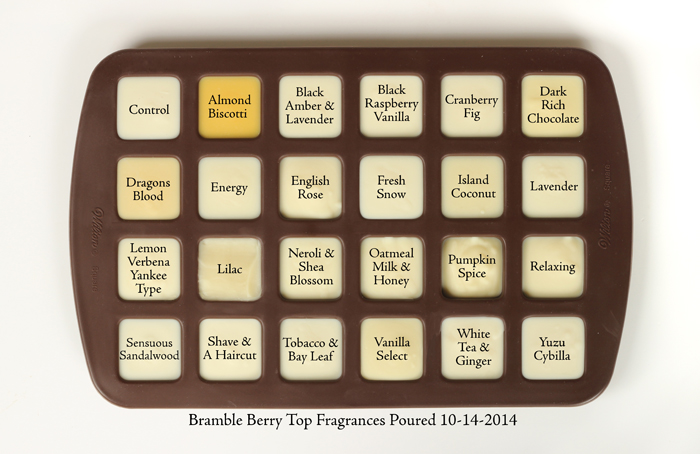
Best Selling Bramble Berry Fragrance Oils, Two Weeks Later
After two weeks, the vanilla discoloration is well under way. Keep in mind, some of these samples (ie: Relaxing Fragrance Oil) have a small amount of soda ash, which makes the color appear slightly lighter. Click here to read more about soda ash.
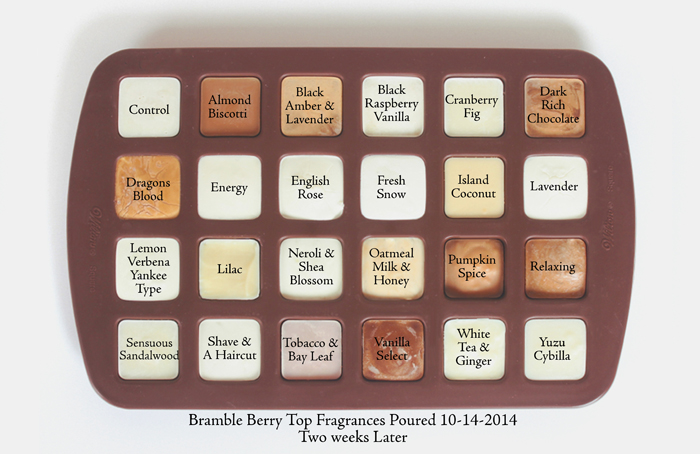
Best Selling Bramble Berry Fragrance Oils, One Month Later (Turned Over)
After one month, the soap is fully discolored. It will no longer continue to darken. The samples below have been turned over to show the discoloration without soda ash. Look how dark the Relaxing Fragrance Oil and Dark Rich Chocolate Fragrance Oil have become! The Pumpkin Spice will eventually go entirely brown as it is fully exposed to air.
If you are planning a soap with lots of bright colors, look for a fragrance oil with minimum discoloration. You can use fragrance oil discoloration to your advantage. You just need to plan your design accordingly! In the Vertical Sandalwood Vanilla with a Twist uses Sandalwood Vanilla Fragrance Oil, which discolors to a deep brown soap. The entire batch is fragranced, while half the batch is lightened with Super Pearly White Mica. The result is two brown hues; the deep brown looks fantastic against the light brown color.
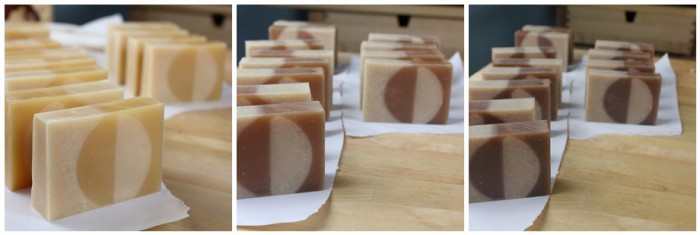
Another beautiful example of fragrance discoloration is the Espresso Shot Cold Process. The discoloration from the Espresso Fragrance Oil along with Brown Oxide creates a striking stripe down the center of the soap. Coffee grounds give the bar exfoliation as well. The result is a bar with striking contrast and plenty of texture.
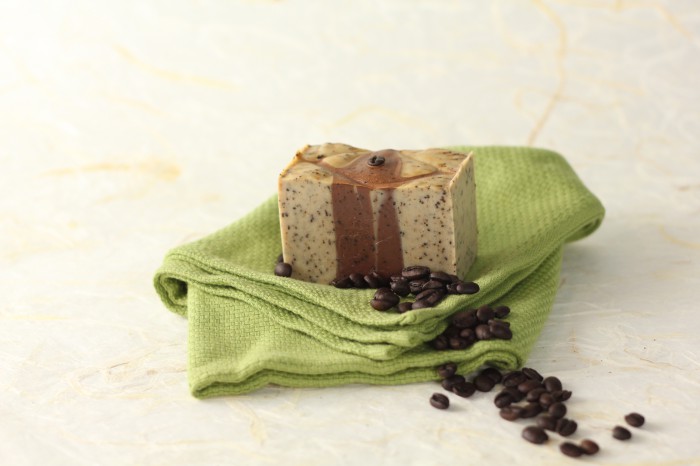 Have you ever used fragrance discoloration to your advantage? I would love to see photos on Instagram, and the Bramble Berry Facebook page!
Have you ever used fragrance discoloration to your advantage? I would love to see photos on Instagram, and the Bramble Berry Facebook page!
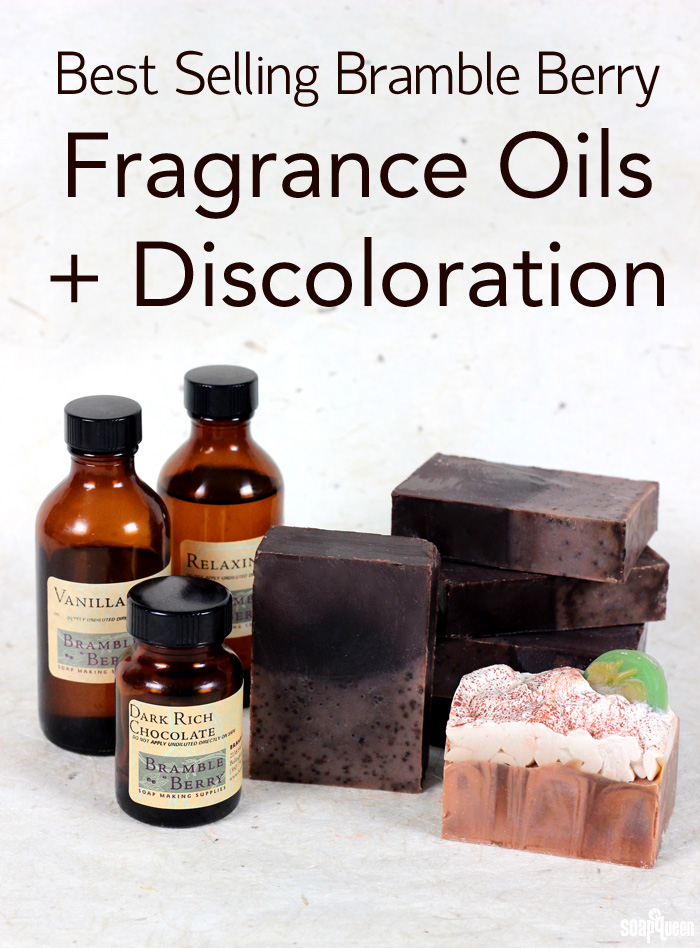
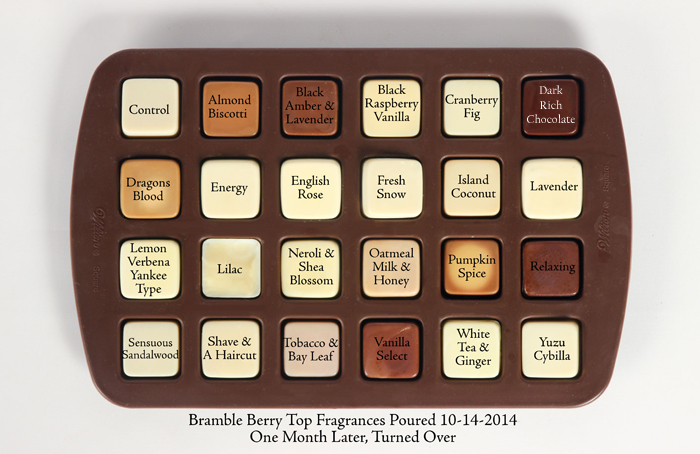




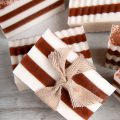
I am having a heck of a time (to say the least) of blending fragrance oils…They are coming out to smell like horse pee…I should know, I raised them…lol I like the flower fragrances like Gardenia and TuberRose (not Tuber Rose Moss) but the floral scents…Can anyone give me some FO recipes so I don’t have people throwing their soap away or at me! Thank you ladies…my email is [email protected]
Hi Victoria!
I can absolutely help you out! In addition to florals, what other scents do you like – fruity, sweet, masculine, clean?
I love florals mixed with clean scents like Green Tea Fragrance Oil. It adds a bit of earthiness.
Green Tea Fragrance Oil: https://www.brambleberry.com/Green-Tea-Fragrance-Oil-P3892.aspx
Bright orange scents mix well with florals too. It adds a sweet citrus note. 🙂
10x Orange Essential Oil: https://www.brambleberry.com/10x-Orange-Essential-Oil-P4441.aspx
Also, this Fragrance Oil Blending Tips post may be helpful for you: http://www.soapqueen.com/bath-and-body-tutorials/tips-and-tricks/fragrance-oil-blending-tips/
-Kelsey with Bramble Berry
I use the Discoloring aspect of the dark rich chocolate and vanilla select in my designs! I add just a single tiny scoop of cappuccino mica to ensure the chocolate dis colors more evenly in my bars. For the vanilla I add a tiny bit to half of my soap base and add vanilla color stabilizer to the other half. Then I pour them together and watch the colors blend! Sometimes the Discoloring makes the design.
Hi there!
That’s awesome! The Cappuccino Mica would help that discoloration turn a warm chocolatey brown color. Discoloration really can work to your advantage. 🙂
-Kelsey with Bramble Berry
Vanilla Select Fragrance Oil: https://www.brambleberry.com/Vanilla-Select-Fragrance-Oil-P3888.aspx
Dark Rich Chocolate Fragrance Oil: https://www.brambleberry.com/Dark-Rich-Chocolate-Fragrance-Oil-P3881.aspx
This post is perfectly timed as I’m trying to start formulating a vanilla cream-y type scent. BUT, I’d like it to stay creamy white – any way to get a vanilla-type scent without the discoloration? (Newbie here so I’m trying to figure out how many different EOs and FOs I need to buy to experiment with. 🙂 )
I should note that this is for CP soap. Thanks!
Hi Karie!
That’s awesome, perfect timing! It is hard to find a creamy scent that won’t discolor. The creamy, warm, sweet notes usually come from vanillin, which causes the discoloration.
However, you make like our Black Raspberry Vanilla Fragrance Oil! It’s fruity and creamy, and doesn’t turn dark brown. 🙂
Black Raspberry Vanilla Fragrance Oil: https://www.brambleberry.com/Black-Raspberry-Vanilla-Fragrance-Oil-P4440.aspx
Almond Fragrance Oil may be an option for you too. It only has a vanilla content of .4%, meaning it doesn’t discolor too much. 🙂
Almond Fragrance Oil: https://www.brambleberry.com/Almond-Fragrance-Oil-P3936.aspx
-Kelsey with Bramble Berry
I kind of want to eat all those soap samples haha! It looks like a box of chocolates!
Absolutely! I got a little hungry when I first saw the pictures. 🙂
-Kelsey with Bramble Berry
You guys are simply the best!!
Hi Rachel!
Thanks so much for saying so! It really means a lot to us. 🙂
-Kelsey with Bramble Berry
Dear SoapQueen,
Thanks very much for these very nice pictures. When buying a FO, I like the info if it accerates trace or discolors. Most of the FO’s I like, have some discoloring tendencies and I do not always know how much that will be in advance. To see them all together like this really shows the differences.
With kind reagrds,
Annemieke
Hi Annemeike!
You’re welcome! It’s interesting to see the soaps next to each other so you can see the differences. So glad you enjoyed the post. 🙂
-Kelsey with Bramble Berry
This was very interesting thank you. People usually associate Vanilla and white so when you have to explain that Vanilla is brown and your soap will go brown it takes some convincing.
Hi Odette!
You’re welcome! Also, that’s true – the first time I saw discoloration I was really surprised! So glad you enjoyed the post. 🙂
-Kelsey with Bramble Berry
Yay! This is so great! I always appreciate the way your site has photos of the frgrances in cold process soap on a lot of the fragrance listings. It’s so helpful not to have to pour through the reviews to find out if it discolors. You can see it and kind of judge if the discoloration will take colors or not from looking at the photos! This sets you apart from the rest 🙂
Hi Margaret!
You’re welcome, so glad you like the post! Also, we test our fragrances vigorously and try to pass on all that information to our customers. I am so glad you find that helpful! Thanks for saying so, your kind comments always mean a lot to us. 🙂
-Kelsey with Bramble Berry
So how would in-the-pot swirl work when taking advantage of discoloration? I like the idea of creating a swirly look without adding colorants. Would you only scent half and then swirl scented with unscented before pouring? Though you wouldn’t really be able to see the effect until later, I imagine.
That is exactly what you would do! I would recommend trying that approach with a fragrance that discolors strongly, so that the swirl is more distinct in the final bar. As a bonus, you should be able to see some difference even before full cure in the really dark ones 🙂
Dear Adrianne,
I tried this once, by mistake… It turned out beautyful! I wanted to make a colomn pour as in AM’s book, but did not pour simultaniously. The only solution to save my soup was to swirl it. Indeed it takes some time before you see the difference in color so making your soap will be much like opening a present.
With kind regards,
Annemieke
Hi Adrianne!
Margaret is correct – you can split your batch and only scent one part of it with a discoloring fragrance. You can scent that part strongly, or use another fragrance that doesn’t discolor. That way you have a fun scent blend and only one part will discolor. We did something similar in the Black and Tan Beer Soap Tutorial: http://www.soapqueen.com/bath-and-body-tutorials/cold-process-soap/soapfest-2011-black-and-tan-beer-soap/
Swirling the discolored soap and non-discolored soap would look amazing too, as Annemeike pointed out. 🙂
-Kelsey with Bramble Berry
Very interesting! Thanks for showing the samples. I often use the vanilla discoloration as part of my planning. It works well if you split batches into two and scent them separately. For example, I make a vanilla and sweet orange soap. I scent half the batch with vanilla FO, and half the batch with sweet orange EO/benzoin (and bump up the orange color with a pinch of red and a pinch of yellow oxide). When the two are swirled, only the half scented with vanilla changes to brown. The final soap is a lovely orange/brown swirl, and the scents still seem blended when the bar is cured. Thanks for all the great ideas!
Hi Leanne!
You’re welcome, glad you found the post interesting! Also, that’s such a great idea – that way you get the vanilla scent but still have a bright color. Thanks so much for sharing. 🙂
-Kelsey with Bramble Berry